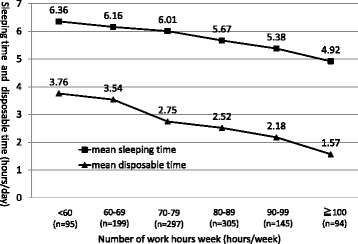The relationship between long working hours and depression among first-year residents in Japan
- PMID: 29587738
- PMCID: PMC5870810
- DOI: 10.1186/s12909-018-1171-9
The relationship between long working hours and depression among first-year residents in Japan
Abstract
Background: In Japan, some residents develop mental health problems. In previous studies, it was reported that long working hours might be a cause of stress reaction such as depression. There were some reports that compared residents with 80 or more working hours with those with less than 80 working hours. However, many residents are practically detained for extra-long time, designated as 100 h or more per week, for medical practice, training, self-study, etc. There have been few reports on extra-long hours of work. This study evaluated the working environment and the amount of stress experienced by first-year residents, and examined the relationship between long working hours and depression, especially in the group of extra-long working hours.
Methods: The study included 1241 first-year residents employed at 250 training hospitals in 2011. A self-report questionnaire was administered at the beginning of the residency and 3 months later to collect data on demographics, depressive symptoms, and training conditions (e.g., duration of work, sleep, disposable time, and night shift). Depressive symptoms were rated using the Center for Epidemiologic Studies Depression Scale.
Results: The mean duration of work per week was 79.4 h, with 97 residents (7.8%) working 100 h or more. At 3 months, clinically significant depressive symptoms were reported by 45.5% of residents working 100 or more h per week, which proportion was significantly greater than that for respondents working less than 60 h (P < 0.001). Multivariate logistic regression analysis showed that a working week of 80 to 99.9 h was associated with a 2.83 fold higher risk and 100 h or more was associated with a 6.96-fold higher risk of developing depressive symptoms compared with a working week of less than 60 h.
Conclusion: Working excessively long hours was significantly associated with development of depressive symptoms. Proper management of resident physicians' working hours is critical to maintaining their physical and mental health and to improve the quality of care they provide.
Keywords: Depression; Medical residency; Mental health; Resident; Work hours.
Conflict of interest statement
Ethics approval and consent to participate
The study was approved by the Ethics Committee of the Faculty of Medicine of the University of Tsukuba. The purpose of this study and measures to ensure secure data management were stated on the first page of the questionnaire. The researchers received written consent from the participants for participation in this study.
Concent for publication
Not applicable.
Competing interests
The authors declare that thay have no competing interests.
Publisher’s Note
Springer Nature remains neutral with regard to jurisdictional claims in published maps and institutional affiliations.
Figures


References
-
- Hisamura M. Physician stress: sex differences in stress tolerance, depressive tendency, and burnout. Sutoresu Kagaku (Jpn J Stress Sci) 1997;12(1):61–64.
-
- Kimura T, Maeno T, Ozaki M, et al. Qualitative research for searching for the stressor of junior resident in Japan. Igaku Kyouiku (Med Ed Jpn) 2007;38(6):383–389.
-
- Maeno T, Nakamura A, Maeno T, et al. Resident stress in the new postgraduateclinical training system. Igaku Kyouiku (Med Ed Jpn) 2008;39:175–182.
MeSH terms
Grants and funding
LinkOut - more resources
Full Text Sources
Other Literature Sources
Medical

